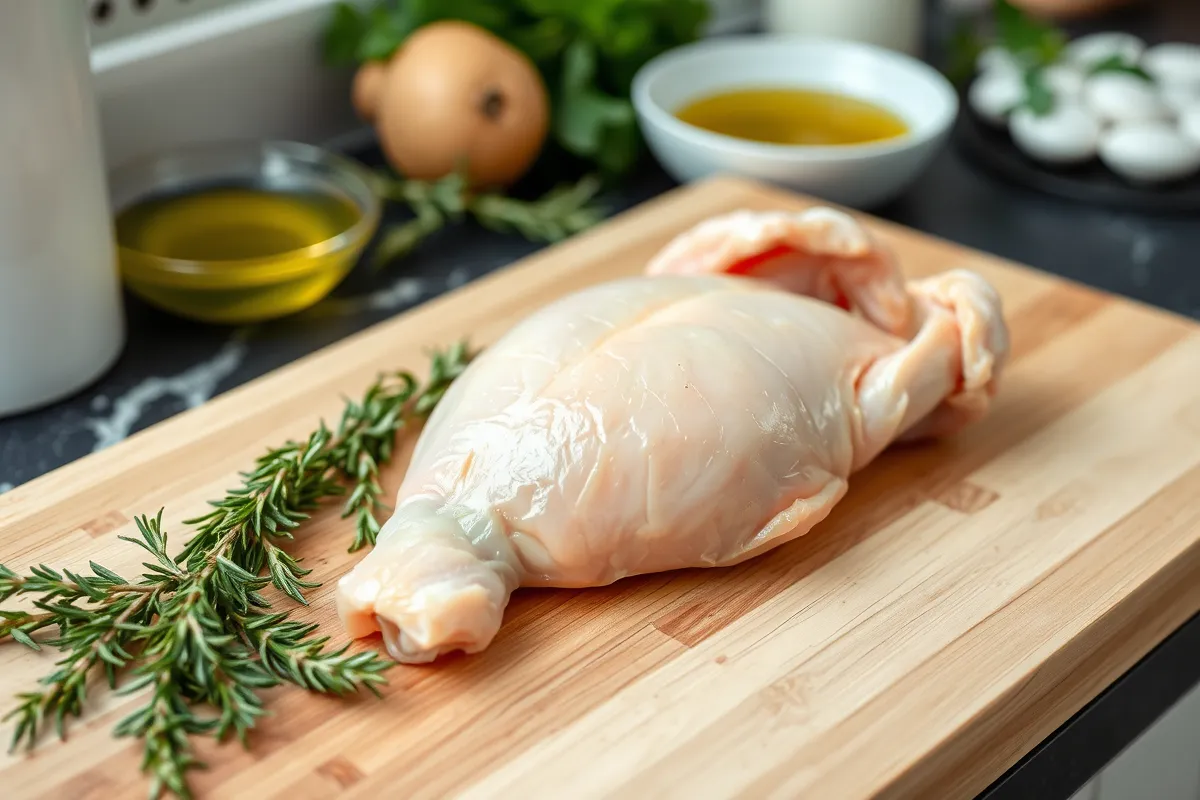Introduction
Chicken is one of the most versatile and widely used proteins in the world. Among the various cuts available, chicken breast and split chicken breast are two of the most popular options. But what’s the real difference between the two? Understanding these distinctions can make a significant impact on your cooking, from achieving perfect texture to balancing flavors.
This article dives deep into the comparison between the two types, breaking down their nutritional profiles, cooking techniques, and when to use each in recipes. Whether you’re a seasoned home chef or a beginner, this guide will help you choose the right cut for your meals.
Understanding Chicken Breast
Definition and Anatomy
A chicken breast is a lean cut of meat derived from the pectoral muscles of the chicken. It is typically boneless and skinless, making it a popular choice for health-conscious cooks. This cut includes both sides of the chicken’s chest, but most stores sell them pre-separated for convenience. Its natural tenderness and mild flavor make it a versatile ingredient for various dishes.
Nutritional Profile
Chicken breast is celebrated for being a high-protein, low-fat option. A 3-ounce serving of boneless, skinless chicken breast contains approximately:
- 140 calories
- 26 grams of protein
- 3 grams of fat
Its low-fat content and lack of skin contribute to its reputation as a healthy choice. For those following a high-protein or low-calorie diet, chicken breast is often the go-to.
Common Culinary Uses
This cut shines in many recipes due to its adaptability. Grilling, baking, and sautéing are popular cooking methods that help preserve its tenderness. It’s frequently used in dishes like:
- Chicken salads
- Stir-fries
- Pasta dishes
Additionally, its neutral flavor pairs well with a variety of seasonings and marinades, making it a favorite for home cooks and professionals alike.
Understanding Split Chicken Breast
Definition and Anatomy
Split chicken breast refers to a chicken breast that is bone-in and skin-on. The term “split” comes from the fact that the whole breast, which includes both sides of the chicken’s chest, is divided into two halves. The presence of the rib bone and skin makes this cut distinct from the boneless, skinless variety. These features contribute to a richer flavor and more robust texture when cooked.
Nutritional Profile
Because this type of chicken retains the skin and bone, its nutritional profile differs slightly from boneless chicken breast. A 3-ounce serving of cooked split chicken breast with the skin includes approximately:
- 170 calories
- 21 grams of protein
- 7 grams of fat
The additional fat content comes primarily from the skin, which also enhances the flavor during cooking. For those seeking more taste and juiciness in their meals, this cut is an excellent choice.
Common Culinary Uses
Split chicken breast is ideal for recipes that require longer cooking times, as the bone helps retain moisture and flavor. Roasting and braising are particularly effective methods for this cut. It’s often used in:
- Slow-cooked soups and stews
- Oven-roasted chicken dishes
- Flavorful chicken stock preparations
Because the skin crisps beautifully when roasted, it adds a delightful texture that appeals to many cooks.
Key Differences Between Chicken Breast and Split Chicken Breast
Bone-In vs. Boneless
One of the most noticeable differences betweenthe two types is the presence of bones. Split chicken breast retains the rib bone, which adds structural integrity during cooking and can enhance flavor. The bone acts as a natural insulator, helping to keep the meat moist during roasting or baking.
In contrast, boneless chicken breast is often favored for its convenience. It cooks faster and is easier to handle, especially for recipes like stir-fries or sandwiches. However, it may dry out more quickly if overcooked, as it lacks the moisture-retaining benefits of the bone.
Skin-On vs. Skinless
The skin is another defining feature. Split chicken breast includes the skin, which adds a layer of fat that enhances flavor and promotes juiciness. When roasted, the skin crisps up beautifully, providing a delicious contrast to the tender meat beneath.
Boneless, skinless chicken breast, however, is leaner and often preferred for health-focused meals. Without the skin, it absorbs marinades and seasonings more directly, making it a versatile option for recipes with bold flavors.
Flavor and Texture
Thanks to the skin and bone, split chicken breast delivers a richer, more robust flavor. The bone contributes to a more complex taste, especially in dishes like soups or slow-cooked meals. The texture of this cut tends to be slightly firmer but remains tender when cooked properly.
On the other hand, boneless chicken breast is mild in flavor and very tender. This makes it a blank canvas for a wide variety of cuisines, allowing the spices, herbs, and sauces to take center stage.
Cooking Techniques and Tips for The Split Chicken Breast and Chicken Breast
Cooking Methods for Chicken Breast

Boneless, skinless chicken breast is best suited for quick cooking methods that help retain its tenderness. Some effective techniques include:
- Grilling: A high-heat grill gives chicken breast a slightly smoky flavor while keeping it juicy if cooked properly. Brining beforehand can improve moisture retention.
- Baking: Baking at 375°F to 400°F ensures even cooking. To prevent drying out, cover the chicken with foil or bake with a sauce or marinade.
- Sautéing: This method is excellent for dishes requiring bite-sized pieces. Using a non-stick pan with a splash of olive oil creates a golden crust while keeping the inside tender.
Regardless of the method, monitoring the internal temperature is essential. The chicken is safely cooked when it reaches 165°F.
Cooking Methods for Split Chicken Breast
Split chicken breast benefits from slower cooking methods that allow the bone and skin to contribute flavor and moisture. Popular techniques include:
- Roasting: Roasting at 400°F helps crisp the skin while the bone locks in juices. Adding herbs and butter under the skin enhances the flavor.
- Braising: Cooking it in a liquid, such as broth or wine, creates tender meat and a rich sauce. This method is perfect for comfort dishes.
- Grilling with Indirect Heat: For those who love grilling, use indirect heat to ensure the meat cooks evenly without charring the skin.
Using a meat thermometer ensures perfectly cooked meat every time, with an internal temperature of 165°F.
Adjusting Recipes Based on Cut
When substituting split chicken breast for boneless chicken breast, account for the additional cooking time required for the bone-in cut. For instance:
- A baked split may take 40–50 minutes at 375°F, while a boneless breast might take just 20–25 minutes.
- Remove the skin if the recipe requires a lighter flavor, but retain it if the dish benefits from the extra richness.
Conversely, when substituting boneless chicken breast for split, reduce the cooking time and consider adding extra fat or marinade to prevent dryness.
Cost and Availability
Price Differences
When it comes to affordability, split chicken breast often has the edge. Because it requires less processing and retains the bone and skin, it tends to be more budget-friendly compared to its boneless, skinless counterpart. On average, it costs around 20–30% less per pound.
Boneless, skinless chicken breast, on the other hand, is priced higher due to the additional labor involved in removing the bone and skin. Its convenience and versatility contribute to its popularity, despite the higher cost.
Market Availability
Both types are widely available at grocery stores and butcher shops. However, the demand for boneless, skinless chicken breast often means it occupies more shelf space. For those looking for split chicken breast, it may sometimes require checking the fresh meat counter or seeking out specialty stores.
Additionally, boneless chicken breast is more commonly available in frozen varieties, making it an easy choice for bulk buying and long-term storage. Split chicken breast, while also available frozen, is typically sold fresh for those planning to cook it within a shorter time frame.
Choosing Based on Cost and Availability
For budget-conscious cooks, the split type offers excellent value. The bone and skin provide added flavor, and the lower price makes it an economical choice for families or large meals. For convenience and versatility, however, boneless chicken breast remains a top pick, especially for quick meals or recipes requiring uniform cuts.
Health Considerations
Nutritional Benefits of Each Cut
Both types are excellent sources of protein, but their nutritional profiles vary slightly.
- Chicken Breast (Boneless, Skinless):
Boneless chicken breast is a lean protein, making it ideal for low-fat diets. It contains fewer calories and less fat compared to split chicken breast. This cut is perfect for those looking to reduce their calorie intake or maintain a heart-healthy diet. - Split Chicken Breast (Bone-In, Skin-On):
The skin on this type adds some fat and calories, which can be beneficial for those needing more energy or flavor in their meals. The bone also adds trace amounts of minerals like calcium and phosphorus, especially if used to make broth.
Suitability for Dietary Needs
- Low-Fat Diets: Boneless chicken breast is a better option due to its lower fat content.
- High-Protein Diets: Both cuts provide high levels of protein.
Healthier Cooking Tips
- For a healthier take on split chicken breast, remove the skin before or after cooking to reduce fat content.
- Use cooking methods like baking or grilling to minimize the use of additional oils or fats.
- Pair both cuts with nutrient-rich sides like steamed vegetables or whole grains to create a balanced meal.
Conclusion
Understanding the difference between these two types of chicken breast can help you make more informed decisions in the kitchen. Boneless, skinless chicken breast is a lean, convenient option that cooks quickly and works well in a wide variety of recipes. It’s an excellent choice for health-conscious individuals or those needing a versatile protein source.
On the other hand, split chicken breast, with its bone and skin intact, offers a richer flavor and juicier texture. This cut is ideal for recipes that benefit from longer cooking times or those looking to enhance the taste of their dishes naturally. Additionally, it’s a more budget-friendly option, making it great for families or meal prepping on a budget.
Whether you choose boneless chicken breast for convenience or split chicken breast for flavor, both cuts have their unique benefits. Selecting the right one comes down to your recipe requirements, cooking style, and personal preferences. By knowing these distinctions, you can ensure your meals turn out delicious every time.
You can find Recipes and Guides in Our Lunch Category with both types, make sure you give them a look.

